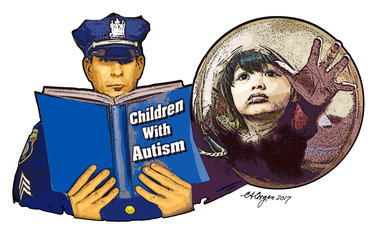The Autism Action Plan — There’s no downside to understanding each other
Last week, the Guilderland Town Board approved spending $77,000 so the town’s 26 police officers and their 13 marked cars can have video cameras. Police Chief Carol Lawlor told us the cameras will protect both the police officers and the public.
The video footage may also serve to educate — both the public and the police.
We just received a link to an Arizona police video sent to us by Assemblyman Angelo Santabarbara. The assemblyman said that watching the video brought him to tears.
It showed a police officer confronting Connor Leibel, a 14-year-old boy with autism.
The reason it moved Santabarbara to tears is because he has a 15-year-old son with autism, Michael, who struggles to communicate. The assemblyman calls Michael his best friend.
“He doesn’t speak too much, but he does communicate,” Santabarbara told us last December when we wrote about his Autism Action Plan.
The pair uses gestures — like thumbs-up — to talk.
The first of Santabarbara’s bevy of bills got a thumbs up from the legislature and the governor who signed into law the creation of a board to advise the health department on setting up of a statewide Autism Spectrum Disorder Program. Members would be made up of state officials, professionals in the field of autism, and family or self-advocates from the autism community.
We watched the video Santabarbara had sent with clear eyes. In it, we saw the need for passing two more of Santabarbara’s bills — one that would make a New York State Autism ID card available to people on the autism spectrum and their families, and another that would provide training to police officers and first responders so that they could successfully interact with people on the spectrum.
Here’s what we saw in the video and what we learned from it.
A police officer stops a boy in a park and asks in a moderate tone, “What’s goin’ on?”
When he gets no answer, he asks more aggressively, “What are you doing?”
When the boy turns, he says more sharply still, “Stop walking away.”
The boy answers, “It’s a string.”
“You have any ID?” asks the officer.
“No,” says the boy
Because the video is from a body camera, which doesn’t have a wide view, it’s hard to see what happens next but the boy screams in anguish several times as he is pinned to the ground by the officer,
“Stay down,” the officer commands. “Don’t move,” he says as heavy breathing is heard.
The officer’s tone changes entirely when Connor’s aunt appears on the scene and explains that Connor has autism.
“Did he hurt somebody?” she asks.
“He started to back away from me,” answers the officer. Connor’s aunt explains that he was afraid.
Connor’s aunt sits at a distance from the officer who apparently still has her nephew pinned and soothes him calmly, saying, “You’re OK.”
We don’t believe the officer was evil. He explains to his superior who arrives on the scene shortly after the incident that he thought the boy had “some type of inhalant” he was bringing to his nose.
The officer had never heard of “stimming,” which Santabarbara explains is self-stimulation, involving repetitive movements which people with autism can use to control their anxiety when they feel stressed. His son, Michael, often stims with a rubberband, Santabarbara says.
Connor’s aunt told the police, “We go through a couple hundred strings” and that Connor stims with shoelaces, too, to calm down.
The superior officer has Connor’s aunt take a picture of the mark on his face. She notes that “his hand was turning white” and that the officer could have let him up.
But she also says, “Your guys’ lives are at risk all the time so I get it. It’s just hard when it’s your own.”
If this had happened in New York State after Santabarbara’s bills were law someone like Connor could have been trained to show a police officer his ID card. And, if the officer had the training the legislation calls for, Connor wouldn’t have had to wait for the aunt to explain to the officer that Connor was autistic.
Connor wouldn’t have been thrown to the ground. The officer would have known why Connor had a string and what stimming was.
Because the aunt was nearby, the situation was diffused. But what if she hadn’t been?
We watched a YouTube video of an event in Miami in July 2016 where a man with autism sat in a road playing with a toy truck. His caretaker, Charles Kinsey, was nearby. As police confronted them, with guns drawn from behind marked cars, Kinsey lay on the ground, his arms outstretched, calling “All he has is a toy truck...I am a behavior therapist at a group home.”
At one point, Kinsey urged the man with autism, “Rinaldo, please be still. Rinaldo, lay on your stomach.” He continued to sit up, playing with the truck.
In the gunfire that followed, Kinsey was wounded.
We wrote in this space just two weeks ago, encouraging police and first responders to get training on on dealing with autism. A Guilderland teenager on the autism spectrum, Nathan Agneta, and his family had been brave to share his story with us. Nathan was charged as an adult at age 16 with a felony after he shared a password with a friend who made empty bomb threats at Guilderland High school. The Agnetas have never been able to find out if the police knew Nathan was autistic.
In our editorial, “Autism and law enforcement — baffling behavior calls for an understanding response,” we pointed out that autism affects one in 68 children born today and is on the rise, almost doubling since the 2004 rate of one in 125. While people with autism are no more likely than the regular population to commit crimes, they are three times more likely to be victims of crimes, so police need to know how to communicate effectively with them.
And as the Arizona police tape of the interchange with Connor Leibel shows, people with autism can be hurt if they are misunderstood.
So we’re ramping up the plea we made on Sept. 14 for understanding, and urging our state legislators to pass these two bills now. We can see no reason not to. And there are as many good reasons for passing the legislation as there are New Yorkers with autism.
“Parents that have a child with autism all want the best for them, which includes providing as much independence as possible,” Santabarbara says. “They worry every time that child steps out of their home that they may be in an emergency situation at school or may have an encounter with law enforcement as an adult.”
Why not help ease that fear?
The legislation would help first responders and police, too. Think how awful a police officer would feel if he harmed or killed a person with autism, not understanding that the object in his hand was a string for stimming and not a gun for shooting.
The presentation of an ID card combined with training could prevent such a tragic outcome.
We’d love to see video footage of a Guilderland Police officer questioning a kid on the spectrum where the kid presents his ID card and the well-trained officer responds with compassion.


